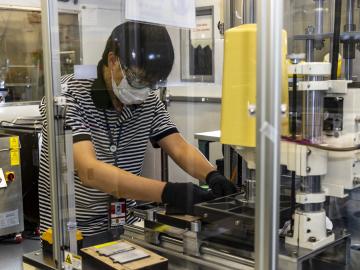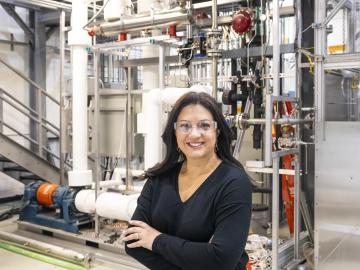
Filter News
Area of Research
- Advanced Manufacturing (4)
- Biology and Environment (18)
- Building Technologies (1)
- Computational Biology (1)
- Computational Engineering (1)
- Computer Science (1)
- Energy Science (43)
- Fusion and Fission (8)
- Fusion Energy (1)
- Isotopes (2)
- Materials (8)
- Materials for Computing (7)
- Mathematics (1)
- National Security (1)
- Neutron Science (20)
- Nuclear Science and Technology (2)
- Supercomputing (8)
News Topics
- (-) Advanced Reactors (2)
- (-) Artificial Intelligence (8)
- (-) Energy Storage (22)
- (-) Mercury (4)
- (-) Neutron Science (23)
- (-) Nuclear Energy (6)
- (-) Security (3)
- (-) Space Exploration (4)
- 3-D Printing/Advanced Manufacturing (27)
- Big Data (7)
- Bioenergy (15)
- Biology (25)
- Biomedical (10)
- Biotechnology (5)
- Buildings (13)
- Chemical Sciences (7)
- Clean Water (8)
- Composites (7)
- Computer Science (36)
- Coronavirus (10)
- Critical Materials (4)
- Cybersecurity (7)
- Environment (43)
- Exascale Computing (3)
- Frontier (4)
- Fusion (9)
- Grid (10)
- High-Performance Computing (19)
- Isotopes (12)
- ITER (4)
- Machine Learning (1)
- Materials (32)
- Materials Science (24)
- Mathematics (1)
- Microscopy (11)
- Nanotechnology (10)
- National Security (7)
- Physics (5)
- Polymers (5)
- Quantum Computing (5)
- Quantum Science (12)
- Statistics (1)
- Summit (9)
- Transportation (23)
Media Contacts

In his career focused on energy storage science, Jianlin Li has learned that discovering new ways to process and assemble batteries is just as important as the development of new materials.

From Denmark to Japan, the UK, France, and Sweden, physicist Ken Andersen has worked at neutron sources around the world. With significant contributions to neutron scattering and the scientific community, he’s now serving in his most important role yet.

Through a consortium of Department of Energy national laboratories, ORNL scientists are applying their expertise to provide solutions that enable the commercialization of emission-free hydrogen fuel cell technology for heavy-duty

Toward the goal of bringing the next generation of nuclear power reactor technology online this decade, ORNL and Analysis and Measurement Services Corporation have successfully completed loop testing of instrument and control sensors for an advanced reactor design for small modular reactors.

When COVID-19 was declared a pandemic in March 2020, Oak Ridge National Laboratory’s Parans Paranthaman suddenly found himself working from home like millions of others.

Scientists at Oak Ridge National Laboratory have devised a method to identify the unique chemical makeup of every lithium-ion battery around the world, information that could accelerate recycling, recover critical materials and resolve a growing waste stream.

The Accelerating Therapeutics for Opportunities in Medicine , or ATOM, consortium today announced the U.S. Department of Energy’s Oak Ridge, Argonne and Brookhaven national laboratories are joining the consortium to further develop ATOM’s artificial intelligence, or AI-driven, drug discovery platform.

Oak Ridge National Laboratory was among an international team, led by Lawrence Livermore National Laboratory, who synthesized 108 elevated carbon dioxide, or CO2, experiments performed in various ecosystems to find out how much carbon is

Scientists have found new, unexpected behaviors when SARS-CoV-2 – the virus that causes COVID-19 – encounters drugs known as inhibitors, which bind to certain components of the virus and block its ability to reproduce.

Researchers at Oak Ridge National Laboratory have identified a statistical relationship between the growth of cities and the spread of paved surfaces like roads and sidewalks. These impervious surfaces impede the flow of water into the ground, affecting the water cycle and, by extension, the climate.


